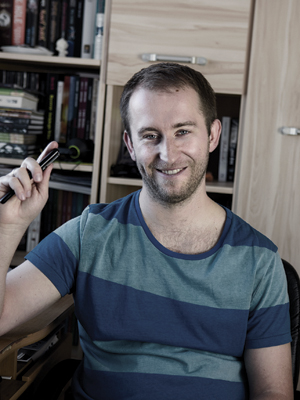 After Bartosz Sztybor, it is his regular collaborator's, artist Piotr Nowacki's turn to answer a few questions before the festival. Again, Aneta Kaczmarek helped with the translation.
After Bartosz Sztybor, it is his regular collaborator's, artist Piotr Nowacki's turn to answer a few questions before the festival. Again, Aneta Kaczmarek helped with the translation.
Antal Bayer: Can Polish artists choose to make a career out of comics, by volunteering for a popular series or character, or are they more or less condemned to do something by themselves and then try to get it published?
Piotr Nowacki: Currently, the Polish market has no series that would be published for years and offer an opportunity for young talented artists to continue them. Honestly speaking, there were some efforts were made to reactivate a few of the vintage, popular titles such as Kajko i Kokosz by Janusz Christa or Kapitan Żbik, created in the Communist era by different artists. Despite the initiative these series were not successful. The young generation of artists has to create their own heroes and series and try hard to get them published. What I am mostly fond of in creating comics is designing my own characters and worlds. I do hope that in the future my characters and books will become as popular with readers as the classic ones remembered by the generations of Poles who grew up on them.
AB: You used to be the editor-in-chief of a magazine called Karton. What was it like, does it still exist? Did you like doing it, and why did this come to an end?
PN: The Karton zine was founded and run by three people, Tomasz Pastuszka, Bartosz Sztybor and me. I was chosen to become the editor-in-chief quite symbolically, because the basic impulse stemmed from my initiative and I was the one who presented the general layout of how it should look. The main idea, the basic foundation we had in mind at the starting point was to publish a regular comic series drawn in a cartoonish manner. We were able to persuade some great Polish artists to join us who liked this style. Apart from the regular list of creators, each issue of the Karton featured a guest artist. We had the great pleasure of presenting works of artists from Mexico, Brazil, Egypt, and, of course Poland. One of the sections was called Pinch of Realism, and it presented improvisations of our own characters drawn by the crème de la crème of Polish artists (and many more) who were realistic artists. Our main goal was to make Karton a cheap magazine available to every comic enthusiast. All 6 issues we have published bear the never-changing 5 PLN price tags (a little more than 1 euro) mainly thanks to the support of sponsors for whom, if they liked this idea, we prepared a special comic advertising their services. Moreover, theses ads constituted a series because of the character of a retired general who appeared in every episode. It’s worth noticing that all covers were created by the same person, Jakub Tschierse. Karton stopped being published after 6 issues because we started to lack time for compiling it. But I hope that at some point in the future I will encounter an opportunity of creating a different magazine because it was really a great experience and a lot of fun.
AB: Tell me a bit about Kapitan Mineta. Who is he, what does he do, where does he appear? Is this a series without end?
PN: Kapitan Mineta is a superhero , we came up with the idea for his adventures with Bartosz for the purpose of the Hardkorporacja zine which was established by our mutual friend, Szaweł Płóciennik. It was supposed to be a periodical thing publishing hardcore, uncompromising material for adult comics readers. We created the adventures of our superhero with this in mind. The action is set in a fictional world of anthropomorphic rabbits ravaged by many villains and the hero has to face them. Often a sexual subtext appears in these stories. After Hardkorporacja came to an end, we moved series to the Kolektyw zine. From the very beginning, our comics were based on a quite vulgar and specific type of humor and at some point it the editors of Kolektyw stopped finding it funny and they decided to finish our cooperation. Well, every cloud has a silver lining, because this turned out to be a positive impulse to start showing the series in a form of mini-books published twice a year for two most important comics festivals in Poland. In one of the issues we even made a parody of my own comic for children, which I created with a different writer. Kapitan Mineta is published in 100 to 150 copies and as all the issues are sold out at that particular events, they have become rarities. Each issue presents a complete story, loosely connected to the others through their characters or situations. The series will be published as long as we don’t get bored with it and it’s doesn’t feel like happening soon.
AB: You have a very nice and clear drawing style, comfortable to read. How did it develop, who were your influences, and who are currently your favorite artists?
PN: My style evolved significantly throughout the years. I didn’t complete any artistic school and I had to learn everything from scratch learning from my own mistakes and attempts and by studying other artists’ ideas. At the beginning my drawings were not very clear and it was hard to see the characteristics of anything, not to speak of my own style. The more I draw, the better my drawings become, and with time they were transformed into a more precise and clear style. Of course, I still make mistakes and I learn all the time. My greatest influences were the classic Polish comics artists who I loved to read in my childhood. These include Bohdan Butenko, Tadeusz Baranowski, Janusz Christa, Szarlota Pawel, Jerzy Wróblewski and Henryk Jerzy Chmielewski. When I started to treat drawing comics more seriously, my modern masters became, among others, Michał Śledziński, Karol Kalinowski and Marek Lachowicz. The foreign inspirations and authors I like are Lewis Trondheim, Mawil, and Bill Watterson.
AB: Do you know any Hungarian comics artists or their works?
PN: Frankly speaking, I don’t know any modern Hungarian comics artists. Years ago, in the Communist period, many adaptation of classic literature pieces were published, such as The Jungle Book, The Good Soldier Švejk, A Connecticut Yankee In King Arthur's Court or The Canterville Ghost – all scripts were written by Tibor Cs. Horváth with drawings by, among others, Ernő Zórád and Attila Dargay. I really liked the latter artist’s style. It was Disney-like in a way, extremely detailed and characteristic. Since in those times not many comic books were published in our country, I read them with great pleasure.
AB: Thank you, see you soon in Budapest.





